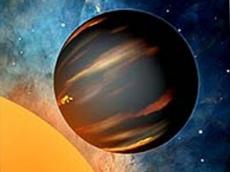|
|
TODAY.AZ / Weird / Interesting
‘Evaporating’ planet discovered around nearby star
07 June 2012 [12:55] - TODAY.AZ
 Astronomers from The University of Texas at Austin and Wesleyan University have used the Hobby-Eberly Telescope at UT Austin’s McDonald Observatory to confirm that a Jupiter-size planet in a nearby solar system is dissolving, albeit excruciatingly slowly, because of interactions with its parent star. Their findings could help astronomers better understand star-planet interactions in other star systems that might involve life.
Astronomers from The University of Texas at Austin and Wesleyan University have used the Hobby-Eberly Telescope at UT Austin’s McDonald Observatory to confirm that a Jupiter-size planet in a nearby solar system is dissolving, albeit excruciatingly slowly, because of interactions with its parent star. Their findings could help astronomers better understand star-planet interactions in other star systems that might involve life.The work is published in the June 1 edition of The Astrophysical Journal in a paper led by Wesleyan University postdoctoral researcher Adam Jensen. The team includes University of Texas astronomers Michael Endl and Bill Cochran, as well as Wesleyan professor Seth Redfield.
The star, HD 189733, lies about 63 light-years away in the constellation Vulpecula, the little fox.
In 2010 another team studied this star in ultraviolet light with the Hubble Space Telescope and discovered that its planet (called HD 189733b) is discharging hydrogen into space.
The Texas-Wesleyan study finds that this streaming hydrogen gas — studied in a different wavelength range by one of the world’s largest ground-based telescopes — is much hotter than anyone knew. This temperature is important: It indicates that the violent flares this star is throwing out are interacting with the planet’s atmosphere.
The planet HD 189733b is not like Earth — it’s a gas giant 20 percent heavier than Jupiter that orbits 10 times as close to its parent star as Mercury does to our sun, an exotic type of planet astronomers have dubbed a “hot Jupiter.”
Astronomers determine the spectrum of a star or planet when spreading out the telescope-collected light into its component wavelengths — a more sophisticated version of passing light through a prism to produce a rainbow. The spectrum is like a bar code that astronomers can read to determine the object’s chemical composition, temperature, speed and direction of motion.
Redfield’s postdoctoral fellow, Adam Jensen, is studying that same set of telescope observations and many more added by Endl in the intervening years. Just determining the spectrum of a transiting planet, let alone being able to decode it, is a difficult feat. As this planet passes in front of its parent star, it blocks only 2.5 percent of the star’s total light, plus another 0.3 percent for the planet’s atmosphere. Teasing out that 0.3 percent and decoding it is the goal.
/spacedaily.com/
URL: http://www.today.az/news/interesting/108366.html
 Print version
Print version
Views: 1838
Connect with us. Get latest news and updates.
See Also
- 19 February 2025 [22:20]
Visa and Mastercard can return to Russia, but with restrictions - 05 February 2025 [19:41]
Japan plans to negotiate with Trump to increase LNG imports from United States - 23 January 2025 [23:20]
Dubai once again named cleanest city in the world - 06 December 2024 [22:20]
Are scented candles harmful to health? - 23 November 2024 [14:11]
Magnitude 4.5 earthquake hits Azerbaijan's Lachin - 20 November 2024 [23:30]
Launch vehicle with prototype of Starship made its sixth test flight - 27 October 2024 [09:00]
Fuel prices expected to rise in Sweden - 24 October 2024 [19:14]
Turkiye strikes terror targets in Iraq and Syria - 23 October 2024 [23:46]
Kazakhstan supplied almost entire volume of oil planned for 2024 to Germany in 9 months - 23 October 2024 [22:17]
Taiwan reported passage of Chinese Navy aircraft carrier near island
Most Popular
 Iran rejects planned transit corridor outlined in Azerbaijan-Armenia pact
Iran rejects planned transit corridor outlined in Azerbaijan-Armenia pact
 India’s Russian oil lifeline under threat as Trump turns up heat
India’s Russian oil lifeline under threat as Trump turns up heat
 Serbia hails U.S.-brokered Azerbaijan–Armenia peace declaration
Serbia hails U.S.-brokered Azerbaijan–Armenia peace declaration
 Witkoff said to meet Qatari PM to discuss Gaza peace
Witkoff said to meet Qatari PM to discuss Gaza peace
 Azerbaijan marks 112th anniversary of people’s artist Kazim Kazimzade
Azerbaijan marks 112th anniversary of people’s artist Kazim Kazimzade
 Ministry of Emergency Situations continues fire safety awareness in liberated territories
Ministry of Emergency Situations continues fire safety awareness in liberated territories
 Damc?l? Cave’s archaeological legacy showcased at ADA University’s Gazakh Center
Damc?l? Cave’s archaeological legacy showcased at ADA University’s Gazakh Center
